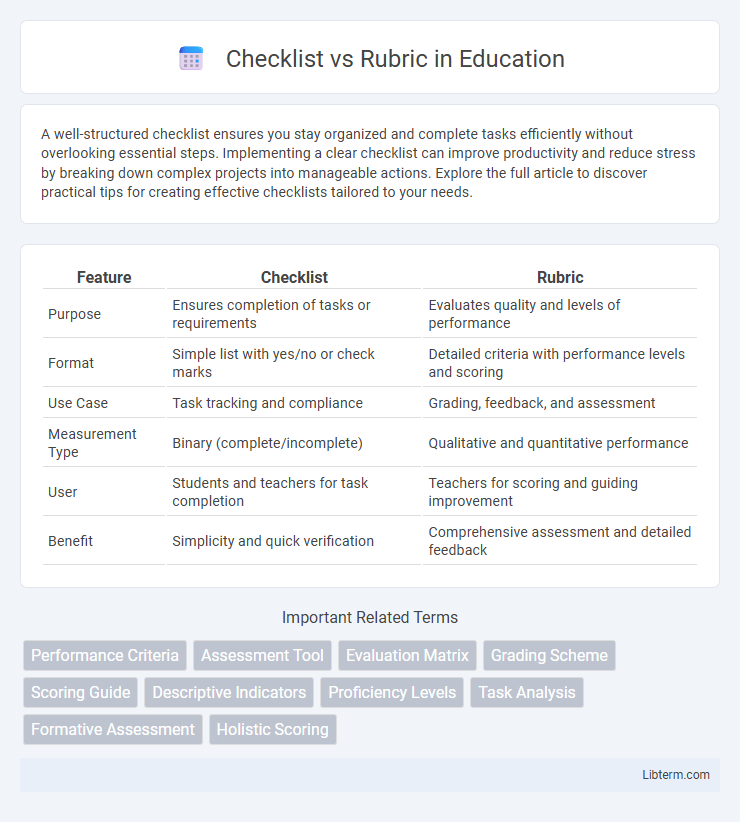A well-structured checklist ensures you stay organized and complete tasks efficiently without overlooking essential steps. Implementing a clear checklist can improve productivity and reduce stress by breaking down complex projects into manageable actions. Explore the full article to discover practical tips for creating effective checklists tailored to your needs.
Table of Comparison
| Feature | Checklist | Rubric |
|---|---|---|
| Purpose | Ensures completion of tasks or requirements | Evaluates quality and levels of performance |
| Format | Simple list with yes/no or check marks | Detailed criteria with performance levels and scoring |
| Use Case | Task tracking and compliance | Grading, feedback, and assessment |
| Measurement Type | Binary (complete/incomplete) | Qualitative and quantitative performance |
| User | Students and teachers for task completion | Teachers for scoring and guiding improvement |
| Benefit | Simplicity and quick verification | Comprehensive assessment and detailed feedback |
Understanding Checklists and Rubrics
Checklists are effective tools that list specific criteria or tasks to verify completion or presence, making them ideal for straightforward assessments and procedural tasks. Rubrics provide detailed performance levels and qualitative descriptors for each criterion, offering nuanced feedback and guiding expectations for complex assignments. Understanding the distinction helps educators choose the appropriate tool for evaluating accuracy versus performance quality in diverse learning contexts.
Key Differences Between Checklist and Rubric
A checklist is a simple tool that verifies the presence or absence of specific criteria, providing a binary yes/no evaluation, while a rubric offers detailed descriptors across multiple performance levels for each criterion, enabling nuanced assessment. Checklists emphasize task completion and are easy to use for quick verification, whereas rubrics assess quality, depth, and degrees of proficiency, supporting consistent and objective grading. The key differences lie in complexity, purpose, and the level of feedback provided, with rubrics fostering comprehensive evaluation and checklists ensuring checklist-style compliance.
When to Use a Checklist
A checklist is ideal for tasks requiring verification of specific, discrete steps, such as attendance tracking or equipment inspections. Use checklists when the criteria are binary and completion-focused, enabling quick confirmation without subjective judgment. They streamline processes by ensuring all necessary actions are completed, supporting consistency in routine or procedural tasks.
When to Use a Rubric
A rubric is essential when assessing complex assignments that require grading multiple criteria such as creativity, organization, and accuracy. It provides detailed performance levels that offer clear expectations and consistent evaluation, especially useful for subjective tasks like essays, presentations, and projects. Rubrics improve feedback quality and help students understand specific areas for improvement, making them ideal for formative and summative assessments.
Advantages of Checklists
Checklists provide a clear, straightforward approach for ensuring all required tasks or criteria are completed, making them ideal for consistency and efficiency in assessments. They reduce ambiguity by offering a binary yes/no evaluation, which simplifies decision-making and accelerates feedback. Checklists also enhance reliability across multiple evaluators by minimizing subjective interpretation, improving overall standardization.
Advantages of Rubrics
Rubrics provide detailed criteria that clarify performance expectations, allowing for consistent and objective grading across diverse assignments. They facilitate targeted feedback by highlighting specific strengths and areas for improvement, enhancing student learning outcomes. Rubrics also promote transparency and fairness in assessment by making evaluation standards explicit and easy to understand.
Checklist vs Rubric: Practical Examples
A checklist provides a simple list of tasks or criteria to be completed, ideal for tracking the presence or absence of specific elements, such as verifying project requirements or ensuring safety protocols are followed. A rubric offers a detailed scoring guide with performance levels and descriptive criteria, useful for assessing the quality of student essays or presentations by assigning scores to categories like content, organization, and mechanics. In practical use, checklists streamline process adherence, while rubrics facilitate nuanced evaluation and feedback in academic and professional settings.
Common Mistakes in Using Checklist or Rubric
Common mistakes in using checklists include overly simplistic criteria that fail to capture the complexity of tasks, leading to superficial assessments. Rubrics often suffer from unclear performance levels or inconsistent descriptors that confuse evaluators and reduce reliability. Both tools can become ineffective when they are not tailored to specific learning objectives or when feedback does not align with rubric or checklist items, limiting their usefulness in guiding improvement.
Tips for Creating Effective Checklists and Rubrics
Creating effective checklists involves clearly defining specific, measurable tasks to ensure consistency and completeness, while rubrics require detailed performance criteria with varying levels of achievement to guide objective assessment. Use precise language and actionable items in checklists for straightforward evaluation, and design rubrics with distinct categories and scoring descriptors to enhance clarity and fairness in grading. Regularly review and refine both tools based on feedback to improve their reliability and alignment with learning outcomes.
Choosing the Right Assessment Tool
Choosing the right assessment tool depends on the learning objectives and desired feedback type, with checklists offering clear, binary criteria for task completion, while rubrics provide detailed performance levels and qualitative evaluation. Checklists are ideal for straightforward tasks requiring accuracy and consistency, whereas rubrics are better suited for complex assignments needing nuanced assessment of various skills or criteria. Educators must consider specificity, ease of use, and the depth of student understanding when deciding between these tools.
Checklist Infographic

 libterm.com
libterm.com